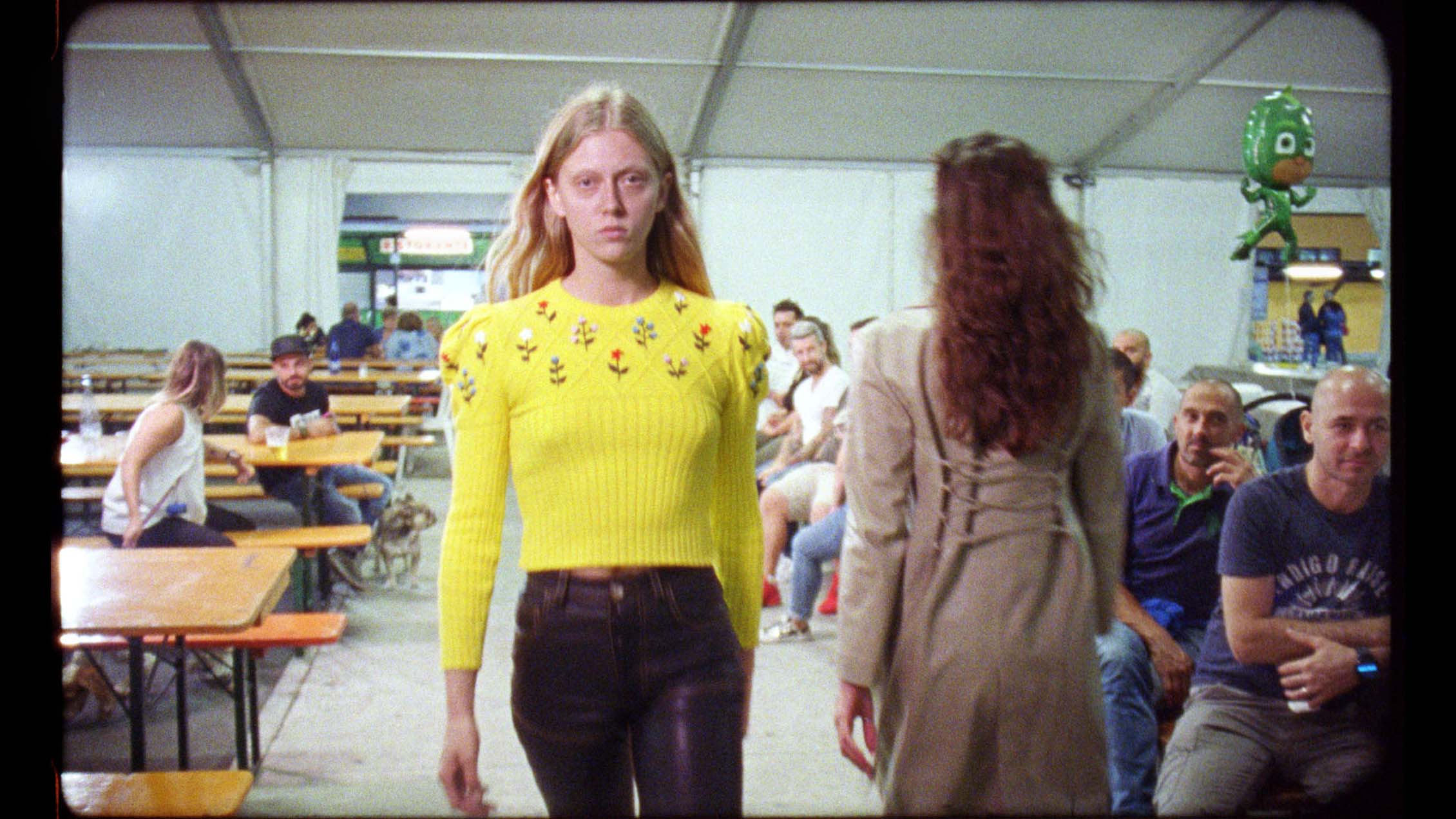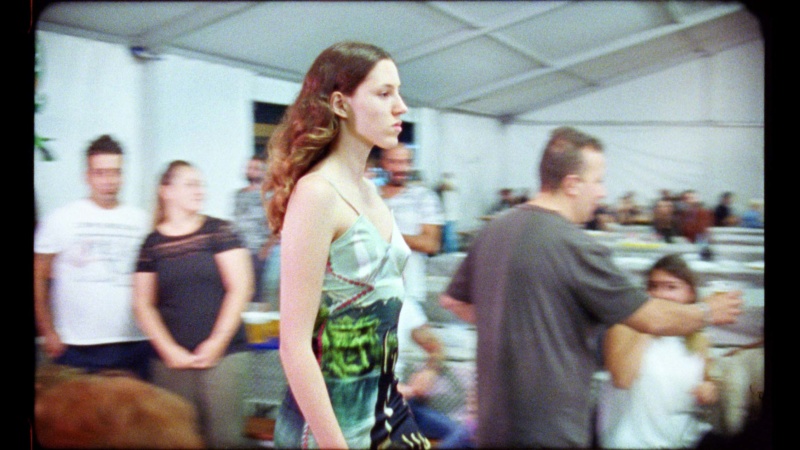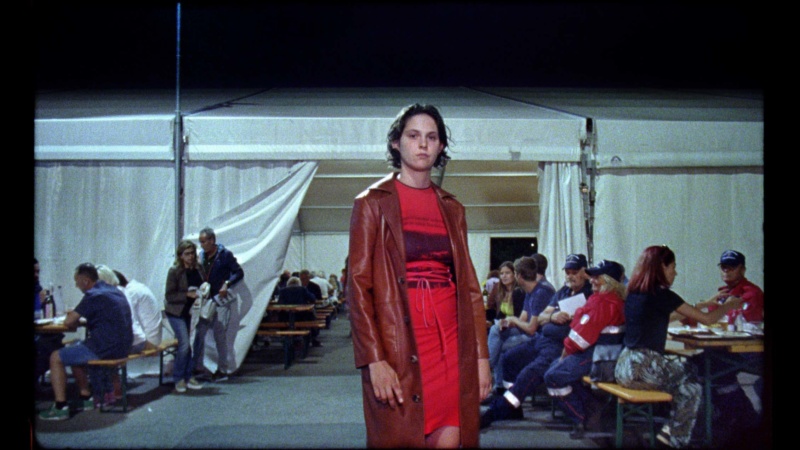
The sagra is rural Italy’s answer to the block party: a small village fête stuffed with the idler’s dreams—hot, juicy drippings of local fare corralled loosely into biergarten-like tents. I remember my chef friend, Alida Borgna, spent a whole summer chasing these kitchen-cooked banquets with friends, picking up regional recipes from neighbors gathered to revel in the season’s bounty.
It was in this setting of lulled merriment that Italian designer Jezabelle Cormio chose to debut her SS20 collection last fall. I watch the show looping on Cormio’s homepage, hypnotized as her printed silk slips, corseted t-shirts and flower-dotted sweaters swept by feasting throngs of beer-warmed patrons. “Sagras are a phenomena that only exists outside the city, just like the craftsman and suppliers I work with,” Cormio says. “As a designer based in Milan, my job is basically driving to the countryside to meet the factory in the field. The clothes are born in that dynamic. And, in this way, it felt like I was just continuing a dialogue I’m already a part of.”

Her claims materialize in the documentation, as lolling onlookers barely parting from trays of steaming food seem at best curious and more often completely indifferent to the runway stunt unfolding around them. “We had to do the run-through multiple times for the film, so, at a certain point, everyone became a part of it. Children ran through the catwalk, old men carried trays for their wives,” Cormio recalls with a smile. “They didn’t have the distance or respect for fashion not to interrupt. You would never be able to create those kinds of interactions at a traditional show.”
These collisions add a funny twinge to the final video, directed by Gregorio Franchetti, and also underline the designer’s interest in the bourgeoisie fetish for and paradoxical rejection of a populist countryside. These class tensions play out aesthetically, and that’s the cottagecore nipple Cormio likes to tweak. “I think what’s on everyone’s mind right now is this new wave of populism that we are observing in every form imaginable,” Cormio says. “And while I’m not choosing to espouse any overt political position as a designer, I’m comfortable bringing fashion back to the province of the people that make it. I’m not glorifying it necessarily, but accepting and including it in my vision of Italy.”

The SS20 collection took off from a very specific reference that Cormio began to notice last year: Roman and Milanese elite donning traditional jackets from Südtirol, a popular skiing destination for Italy’s upper classes, and also the last stronghold of a particular vein of folkloric traditions and crafts stemming from Bavaria, Austria and Germany. “It is a certain kind of Roman who plays this kind of dress up. It’s a way of saying, ‘I go to these places during the holidays,’” Cormio sighs. “And, of course, the issue is only compounded when the coat is an actual heirloom—worn down in the elbows to show people just how far the money goes.” Cormio argues that the rich want to create a closeness to an idealized countryside, while falling just short of any actual participation or investment in its history or future.
The designer embraces not only the glamorous and wholesome Südtirol image but also its flip side: the aprons and napkins stitched with dated slurs, the grease trays of the schnitzel truck, the palpable anger of a population becoming increasingly radicalized by the direct impact of climate catastrophe on agrarian life. Take, for example, her rudimentarily silk screen tees emblazoned with German phrases like: everything has an end, only a weiner has two. On these pieces, Cormio also evokes the dirndl, a traditional German corset, by criss-crossing silk ribbons over the shirt’s midsection. The result lands somewhere in between; the buxom milkmaid cannot divorce her nihilism. “I didn’t go completely vulgar. I didn’t have the two pigs fucking with ‘How Ham Gets Made’ written under it,” Cormio laughs. “Maybe I will in the future, but for now I went for fake wisdom, which might be worse.”

False history enters the collection vis-à-vis The Sound of Music, which Cormio describes as “Austria’s least-screened film.” “[The Sound of Music] is an American fantasy,” the designer says. “It’s a super idealized image of the countryside as an escape route from the evils of urban life. I also find the film interesting because it proves how we romanticize the story of escape from persecution when it’s rich white people doing it. We are happy to embrace a story of survival or immigration, but only when the underdog resembles us.” In the collection, Cormio evokes the film through a series of repeated photo prints, some taken from the film stills, others constructed in photoshop. In all the prints, bodies are absent, represented instead by shadow figures that we can imagine ourselves filing out, like state fair cut-outs.
Cormio’s perspective on the countryside is undoubtedly shaped by her direct and admitted reliance on the network of artisans and craftsmen who bring her delicate pieces to life—a point perfectly summarized in the label’s current slogan: “Made All Over Italy.”
I wonder if retailers like Forever 21 and Zara were forced to create more transparency around their supply chains, how their output might change. Would it change the value we assign to garments and each other? Could fashion help reveal our interdependence and stoke a more equitable exchange between city and countryside? For her part, Cormio is approaching the subject like a weiner—from both ends.











 in your life?
in your life?

